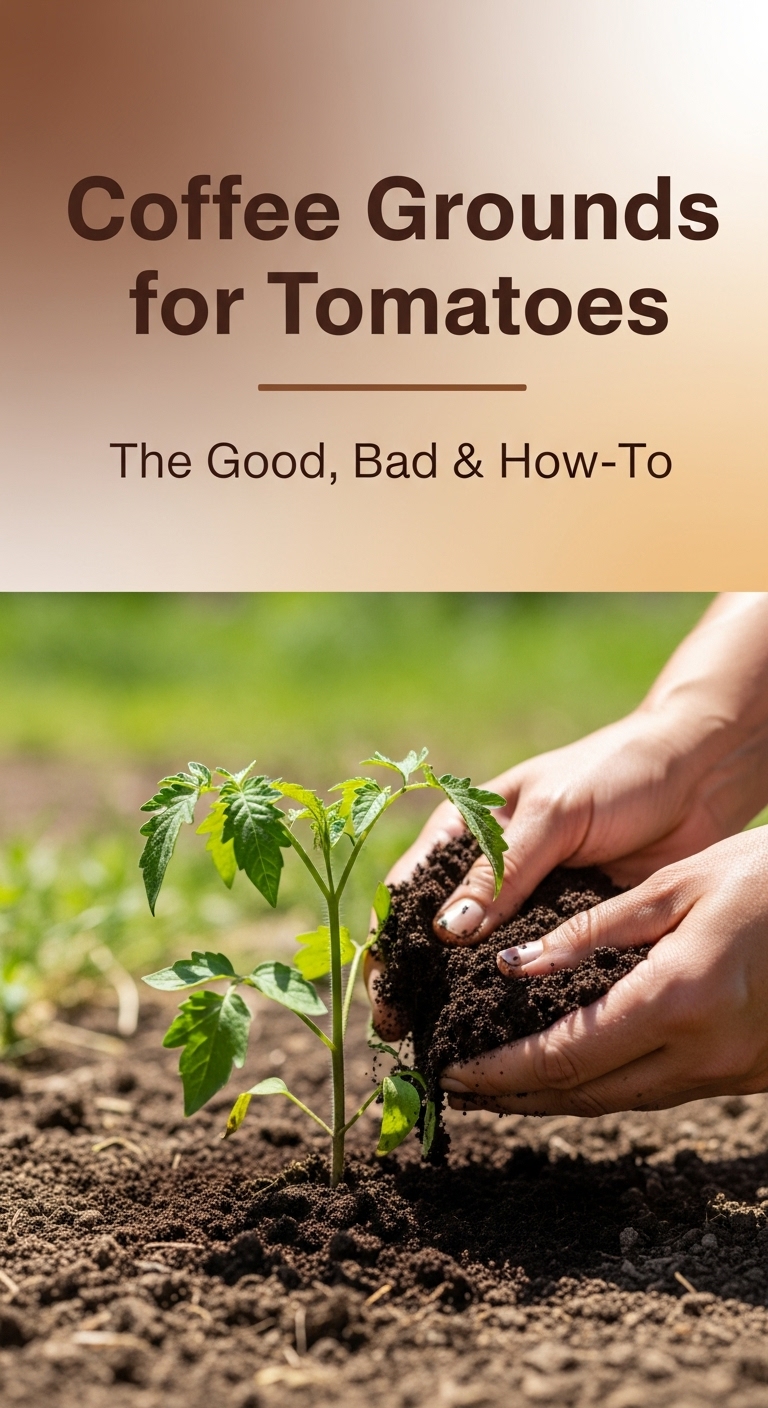As an Amazon Associate CoffeeXplore.com earns from qualifying purchases.
Coffee Grounds for Tomatoes: The Good, Bad & How-To
So, can your morning coffee habit really lead to a better tomato harvest? The answer is more complex—and interesting—than you might think. Many gardeners swear by using coffee grounds on tomato plants, while others warn of potential dangers. This guide cuts through the confusion, relying on soil science and established gardening best practices to give you the definitive answer.
Yes, used coffee grounds can be good for tomatoes when used correctly, primarily as a soil amendment within compost. They provide slow-release nutrients and improve soil structure, but applying them improperly can harm your plants.
Leveraging extensive analysis of gardening data and established horticultural patterns, this guide unpacks the proven benefits, the real risks, and the exact methods you need to follow. We’ll cover what’s actually in your spent grounds, how they help your soil, the mistakes to avoid, and the three best ways to use them for a healthier, more productive tomato patch.
Key Facts
- Ideal pH Compatibility: Used coffee grounds have a pH ranging from 5.5 to 6.8, which is nearly perfect for tomato plants that thrive in a soil pH of 6.0 to 7.0.
- Slow-Release Nutrients: The nitrogen and other nutrients in coffee grounds are not immediately available. It takes several months for soil microbes to break them down and release them for plant use.
- Composting is Safest: The most recommended and safest application method is composting. To maintain a healthy compost pile, coffee grounds should make up no more than 10-20% of the total volume.
- Risk of Compaction: Applying a thick layer of wet coffee grounds directly to the soil surface can create a dense, water-repellent mat that blocks air and moisture from reaching plant roots.
- Potential Growth Inhibition: The trace amounts of caffeine remaining in used grounds can inhibit seed germination and stunt the growth of young seedlings.
The Science of Coffee Grounds: What’s Really in Them?
Before you sprinkle your leftover coffee grounds around your tomato plants, it’s crucial to understand what you’re actually adding to your soil. A common myth is that used grounds are highly acidic, but the science tells a different story. The brewing process washes away the vast majority of acid, leaving a material that is surprisingly beneficial when understood correctly.

The key takeaway is that the nutrients in are used coffee grounds good for tomatoes are locked up. They aren’t a quick-fix fertilizer but rather a long-term soil conditioner that requires biological activity to unlock its potential.
| Chemical Property | Value/Description | Impact on Tomatoes |
|---|---|---|
| pH Level | 5.5 – 6.8 (Mildly Acidic to Neutral) | Perfectly compatible with the ideal pH range for tomatoes (6.0-7.0), so it won’t harmfully alter soil acidity. |
| Nutrient Content | Contains Nitrogen (approx. 2%), Potassium, Phosphorus, Calcium, and Magnesium. | Provides a source of essential macronutrients and micronutrients that support overall plant health and growth. |
| Nutrient Availability | Slow-release. Nutrients are bound in organic compounds and require months of microbial decomposition. | Acts as a long-term soil enricher, not a fast-acting fertilizer. It feeds the soil ecosystem, which in turn feeds the plants. |
Quick Fact: Despite the common belief, the brewing process washes away most of the acid, leaving grounds with a pH perfect for tomatoes.
The Benefits: 4 Ways Coffee Grounds Help Tomato Plants Thrive
When used properly, adding coffee grounds to your garden soil can provide significant advantages for your tomato plants. These benefits go beyond simple nutrition, helping to create a healthier overall growing environment from the ground up.
Pro Tip: Think of coffee grounds less as a ‘fast food’ fertilizer and more as a long-term ‘health food’ investment for your garden soil.
1. Improves Soil Structure and Health
Used coffee grounds are a fantastic source of organic matter. When mixed into the soil, they help improve its physical properties. For heavy clay soils, they improve drainage and reduce compaction. For sandy soils, they help retain moisture and nutrients near the plant’s roots. This improved structure allows for better aeration and water penetration, creating an ideal environment for strong root development.
2. Provides Slow-Release Nutrients
Tomatoes are heavy feeders, and coffee grounds offer a steady, slow supply of essential nutrients. As soil microbes break down the grounds over several months, they gradually release nitrogen, potassium, phosphorus, and other vital micronutrients like calcium and magnesium. This slow-drip feeding process helps support sustained, healthy growth throughout the season.

3. Stimulates Beneficial Soil Life
Healthy soil is alive with a complex web of microorganisms and earthworms, and coffee grounds are an excellent food source for them. This stimulation of beneficial microbial activity is critical for nutrient cycling, which is the process that makes nutrients in the soil available to your tomato plants. Furthermore, earthworms are drawn to coffee grounds. As they tunnel through the soil, they further enhance aeration and soil structure.
4. May Help Suppress Fungal Diseases
Some research suggests that the microorganisms that thrive on decomposing coffee grounds can help protect plants from harmful pathogens. Studies have shown that these beneficial microbes may suppress common fungal diseases like Fusarium and Pythium. While not a guaranteed fungicide, adding composted coffee grounds can contribute to a more resilient and disease-resistant garden ecosystem.
The Risks & Myths: When Coffee Grounds Can Harm Your Tomatoes
While the benefits are appealing, using coffee grounds incorrectly can do more harm than good. It’s vital to be aware of the potential downsides and common myths to avoid making mistakes that could damage your tomato plants or waste your efforts.
Relatable micro-analogy: Applying a thick layer of wet coffee grounds is like putting a waterproof cap on your soil—it keeps the good stuff (air and water) from getting to the roots.
Here are the key risks to understand:
- Soil Compaction & Water Blockage: This is the most significant risk. When applied as a thick top dressing, fine coffee grounds can lock together and form a dense, impenetrable crust. This mat prevents water and air from reaching the soil and your tomato’s roots, effectively suffocating the plant.
- Potential for Mold Growth: A thick, damp layer of coffee grounds is an ideal breeding ground for mold and mildew. While not always harmful, excessive mold can be unsightly and may attract unwanted pests to your garden.
- Caffeine Can Inhibit Growth: Although much of the caffeine is washed out during brewing, trace amounts remain. This residual caffeine can act as an allelopathic chemical, meaning it can inhibit the germination of seeds and stunt the growth of young, delicate seedlings. It’s a key reason to avoid using fresh grounds near seeds.
- The Pest Control Myth: A widely circulated idea is that coffee grounds repel pests like slugs and snails. While very high concentrations of caffeine are toxic to them, the amount in used grounds is far too low to be an effective deterrent. Don’t rely on coffee grounds for pest control.
- Not a Balanced Fertilizer: Coffee grounds provide some nutrients, but they are not a complete or balanced fertilizer. Relying on them alone will leave your heavy-feeding tomato plants deficient in key nutrients they need for robust growth and fruit production.
The Right Way: 3 Best Methods to Use Coffee Grounds for Tomatoes
Now that you understand the good and the bad, let’s focus on the solution. To harness the benefits of coffee grounds without falling victim to the risks, you must use the right application method. Here are the three safest and most effective ways to incorporate are used coffee grounds good for tomatoes into your gardening routine.
Method 1: The Gold Standard – Composting Coffee Grounds
Composting is, without question, the best and most highly recommended way to use coffee grounds in the garden. This process safely breaks down the grounds, neutralizes any remaining growth-inhibiting compounds, and fully integrates their nutrients into a rich, stable soil amendment that your tomatoes will love.
- Identify as “Green” Material: In composting terms, coffee grounds are a “green” material because they are rich in nitrogen.
- Balance with “Browns”: To create healthy compost, you must balance nitrogen-rich “greens” with carbon-rich “brown” materials. Good brown materials include dried leaves, straw, shredded cardboard, and wood chips.
- Maintain the Right Ratio: Aim for a ratio where coffee grounds make up no more than 10-20% of the total compost pile. A simple rule of thumb is to add 2-3 buckets of brown materials for every 1 bucket of green materials (which includes your coffee grounds and other kitchen scraps).
- Apply Finished Compost: Once the compost is dark, crumbly, and smells like rich earth, it’s ready. Work a 1-2 inch layer of this finished compost into the soil of your tomato beds before planting or as a top dressing during the growing season.
Pro Tip: A simple rule ofthumb: for every bucket of coffee grounds, add 2-3 buckets of dried leaves or shredded paper to your compost pile.
Method 2: Cautious Direct Application
If you don’t have a compost pile, you can apply coffee grounds directly to the soil, but you must do so with extreme caution to avoid the risk of compaction. This method is best for established, healthy tomato plants, not for seeds or new seedlings.
Warning: Never apply a thick layer of fresh coffee grounds as mulch. Always rake a thin layer (no more than 1/2 inch) into the topsoil to prevent it from forming a dense, water-blocking mat.
- Sprinkle Sparingly: Lightly sprinkle a very thin layer of dry, used coffee grounds on the soil surface around your established tomato plants.
- Keep it Thin: The layer should be no more than half an inch thick. You should still be able to see the soil through the grounds.
- Work it In: Immediately after sprinkling, use a hand rake or cultivator to gently work the grounds into the top 1-2 inches of soil. This prevents them from forming a crust.
- Mix with Mulch: Another safe option is to mix the grounds with a coarser mulch material, like straw or wood chips, before applying. This helps maintain good air and water flow.

Method 3: Making a “Coffee Tea” Liquid Fertilizer
For a gentle and immediate nutrient boost, you can create a weak liquid fertilizer, often called “coffee tea.” This method extracts some of the water-soluble nutrients from the grounds and allows you to apply them easily during your regular watering routine.
- Combine Ingredients: Place 2 cups of used coffee grounds into a 5-gallon bucket. Fill the bucket with water.
- Let it Steep: Let the mixture steep for several hours or overnight, allowing the nutrients to leach into the water.
- Water Your Plants: Use the resulting light brown “tea” to water the soil at the base of your tomato plants. You can strain the grounds out first or leave them in, as they will be well-dispersated and won’t cause compaction issues when applied with this much water.
To ensure you’re using the best and safest method—composting—having the right equipment makes all the difference. A high-quality compost bin simplifies the process of balancing materials and speeds up decomposition, turning your kitchen scraps and coffee grounds into “black gold” for your garden more efficiently.
FAQs About Using Coffee Grounds for Tomatoes
How often should I put coffee grounds on my tomato plants?
The frequency depends entirely on the method. If you are applying finished compost that contains coffee grounds, you typically only need to do this once or twice a season when preparing the bed or as a mid-season top dressing. If using the direct application method, do it very sparingly—once a month at most—to prevent buildup. A “coffee tea” liquid fertilizer is much gentler and can be used every one to two weeks as part of your regular watering schedule.
Can you put too much coffee grounds on tomato plants?
Absolutely, yes. Using too many coffee grounds is one of the most common mistakes. Excessive amounts, especially when applied directly to the soil surface, will lead to negative consequences. These include creating a compacted, water-repellent layer, promoting mold growth, and potentially stunting plant growth due to the concentration of certain compounds. Moderation is critical.
Are coffee grounds and eggshells good for tomatoes?
Yes, this is a classic and beneficial garden combination. When composted together, coffee grounds and crushed eggshells create a fantastic soil amendment. The coffee grounds provide nitrogen and organic matter, while the eggshells slowly break down to provide a valuable source of calcium. Adequate calcium is essential for tomato plants to prevent blossom end rot, a common issue where the bottom of the fruit turns black and rots. Both are best used by adding them to your compost pile first.
Are coffee grounds good for other vegetable plants, like peppers or cucumbers?
Yes, the same principles that apply to tomatoes generally apply to most other vegetable plants that prefer slightly acidic to neutral soil, including peppers, cucumbers, and squash. The benefits of improved soil structure and slow-release nutrients are universal. Likewise, the risks of direct application (compaction, mold) also remain the same. For any plant, the safest and most effective method is always to incorporate the coffee grounds into a well-balanced compost pile first.
Final Summary: Using Coffee Grounds Wisely for a Better Harvest
The verdict is in: are used coffee grounds good for tomatoes? Yes, but with important conditions. They are not a magic bullet fertilizer but a valuable soil amendment that can contribute to a healthier, more productive garden when used correctly. By understanding their properties and respecting the risks, you can turn a waste product from your kitchen into a powerful ally for your tomato plants. The key is to see them as food for your soil, not just for your plants.
Here are the most critical takeaways for success:
* Do prioritize composting your coffee grounds. It is by far the safest and most effective method.
* Don’t apply thick layers of fresh grounds directly onto your soil, as this can block water and air.
* Do think of coffee grounds as a slow-release soil conditioner, not a fast-acting fertilizer.
* Don’t rely on coffee grounds alone; they must be part of a balanced fertilization and soil management plan.
Now that you know the science and the safest methods, go ahead and give your coffee grounds a second life in your tomato patch
Last update on 2025-12-15 / Affiliate links / Images from Amazon Product Advertising API

